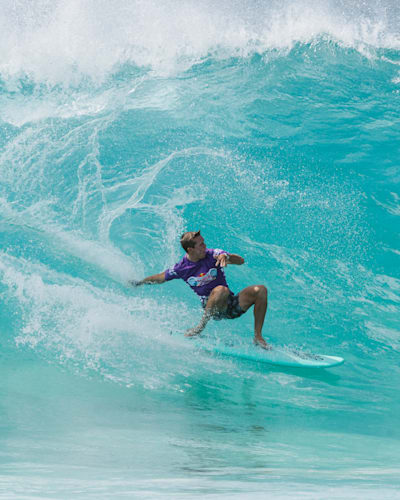
Surfing
A guide to the most prominent surfboard designs, along with tips for choosing the best surfboard for you.
Spending the day catching waves is one of the greatest thrills in life. No one knows that better than Red Bull surfer Kolohe Andino. The California native dedicates his life to the sun, saltwater, and surf for one very simple reason.
“I surf because I love it!” he says.
If you want to fall in love with the waves, too, it’s important to set yourself up for success with the right surfboard. There’s a ton of nuance around surfboard construction, but you’ll often hear the question framed as a choice between foam vs. fiberglass surfboards.
01
History of surfboards
The art of surfboard design has evolved a ton in the centuries since the sport was invented — the first surfboards were carved from wood planks. Still, even in 16th-century Hawai’i, surfboards were shaped for optimum performance for different surfing abilities. For instance, the smallest surfboard shape, the Paipo — a prototype for what we know today as bodyboards — was ideal for children learning to surf.
Foam and fiberglass composite surfboards made their debut in the 1940s after World War II accelerated innovation on construction materials. Fiberglass fins were introduced in the 1960s, replacing mixed designs that combined fiberglass with wood. By the 1980s, epoxy resin had become another commonly used material. At the time, surfers felt stifled by the stiff material, but resin technology has advanced in the decades since then. Now, you get a great flex with epoxy resin.
Today, you’ll often find surfboards that are made from a range of materials blended for the best performance. It can be challenging, though, to find the right blend for your style. The best place to start is choosing between a foam soft top or fiberglass hard top surfboard.
02
What is a foam surfboard?
Foam surfboards, otherwise known as soft top boards, are made with a foam core and a soft outer shell. The core is usually made up of expanded polystyrene (EPS) foam, while the outside is coated in either ethylene-vinyl acetate (EVA) or Diamond Grip. The outer coating helps to extend your soft top board’s lifespan, protecting it from dents and scratches. These surfboards are often way more affordable than their hard top counterparts.
Foam soft top boards are one of the best types of surfboards for beginners. The foam core and thick coating make for a buoyant, stable board, so you’ll find it easier to stand up on a wave. Plus, the soft edges mean that if you fall off, you’re less likely to get bruised by your surfboard, unlike with hard top boards. You can probably find a soft top surfboard designed for beginners at your local surf shop.
Soft top boards aren’t perfect, though. These boards don’t go as fast or respond as quickly as hard top boards. If you’re past the early stages of learning to surf, using a soft top board can get a little frustrating. They’re also more susceptible to damage if you hit something hard or sharp in the water. Somewhere you'll see a lot of foam boards is at Red Bull Foam Wreckers, the anti-surf-contest surf contest where only soft-boards are allowed and anyone can participate.
03
What is a fiberglass surfboard?
Certain kinds of hard top surfboards are often referred to as fiberglass surfboards, but there’s some debate about this language in the surfing community. Folks using this term are referencing hard tops with a polyurethane core and fiberglass cloth outer shell. These surfboards often include a composite of foam, fiberglass, and resin coating. So while you’ll see surf shops that sell fiberglass surfboards, some people might argue that there’s no such thing.
Nevertheless, if you choose a hard top advertised as a fiberglass surfboard, there are some significant advantages. Intermediate surfers aiming for high speeds will do well with hard tops coated in fiberglass. If you love to do tricks or sharp carves, this type of board is also more likely to respond to your commands immediately. These surfboards are on the more expensive side, but the investment will be worth it if you surf a lot since you’ll get extra durability.
Additionally, since hard tops can be heavier, they can take more muscle to maneuver, which can tire you out after a long day. The other downside is that injuries may be more likely with a hard top board. If a wave knocks you off and you end up colliding with your board in the current, it won’t be pleasant.
Comparing foam and fiberglass surfboards
If you’re deciding between a soft top foam board or hard top fiberglass board, these are the main factors to consider.
- Speed vs. easy balancing. Hard and soft top surfboards both perform great under the right conditions. If good performance, to you, means a surfboard you can stand up on with no challenges, a foam-core board is the right choice. But if you’d rather treat surfing like a race against the waves, a hard top board will help you zoom through the water.
- Off-the-shelf vs. custom-made. Fiberglass-coated surfboards can often be tailored to your liking. If you’ve ever dreamed of designing your own personalized surfboard, you can make it happen with a hard top.
- High vs. low maintenance. Fiberglass surfboards don’t last long without regular care. You’ll need to wax them much more frequently than a soft top surfboard.
Who should use a foam surfboard?
Besides being the easier choice for new surfers, foam soft top surfboards are great for anyone learning a trick for the first time. You can be a little more playful on a soft top, so practicing a new move might feel a little lower-stakes. Soft tops can be the perfect surfboards for surfers who are above beginner level but not quite intermediate yet. A foam soft top is great when you need to practice turns and not worry about falling off and banging into your surfboard.
Foam soft tops can also be perfect for trying out new surfing locations, especially shallower shore breaks. If you end up surfing on a day with smaller waves, foam soft tops can handle those like a breeze. These boards also have less of an upward bend, or rockered camber, at the nose, so collisions with shallow sand won’t destroy your board.
Who should use a fiberglass surfboard?
Are you the kind of surfer who thrives on tight turns and explosive snaps? Fiberglass hard tops help you move through waves like butter as you pull off trick after trick, responding easily at the slightest shift.
Fiberglass hard tops are better if you love to surf a rockier beach, and their durability extends beyond enduring impacts. They’re also less likely to wear down from the typical saltwater and sun you get at any location.
When you’re ready to take your skills up a notch, try out a fiberglass hard top surfboard. You’ll get to feel every little movement of the waves underneath you, so you’ll get even better at reading the water. Since you’ll have to paddle out a bit harder with a fiberglass hard top, your overall fitness and endurance will get an incredible boost.
04
Care and maintenance tips
Whether you prefer a foam soft top or a fiberglass hard top, follow these maintenance tips so that your board lasts for years.
- Cleaning. After a long day in the water, make sure to rinse all that saltwater off so it doesn’t harden on your surfboard. A salty surfboard makes it nearly impossible to remove your fin box later.
- Storage. Leaving your surfboard in the car overnight can lead to heat damage. Even when the temperature is moderate outside, the direct sunlight can turn your car into a surfboard oven. Storing your surfboard in a padded storage bag offers additional protection. It’s easy to forget how quickly you can scratch up your surfboard before you even get in the water, especially with a foam soft top.
- DIY repairs. It’s important to catch small scratches before they turn into big problems. Your local surf shop can help you find a repair kit so you can make small touch-ups at home. Leave larger damage to the pros at your local surf shop.
Make your choice and hit the waves
In the fiberglass vs. foam surfboard debate, there’s no right or wrong. It’s all about assessing your skill level and preferences and finding the best fit for your unique style. You can always rent out different models at your local surf shop if you’re still not sure. After all, there’s no better way to test out a surfboard than taking it for a spin in the water.





